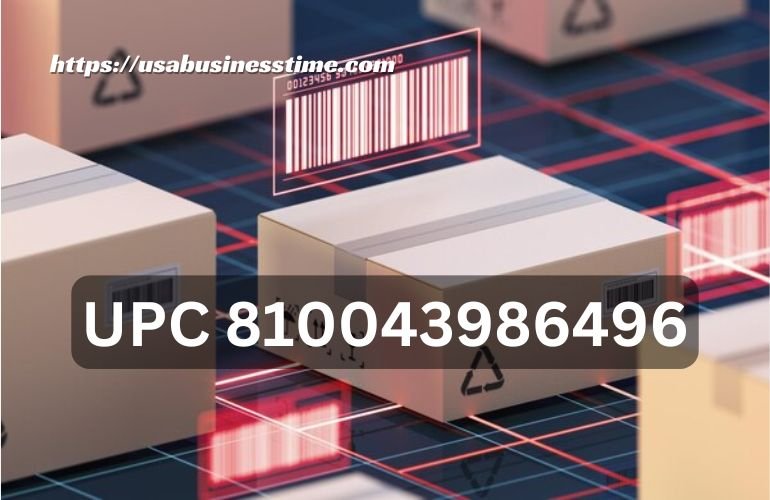A UPC 810043986496, is a unique identifier used to track and manage products in various industries. It plays a key role in retail, e-commerce, and supply chains by enabling quick and accurate identification of items. UPCs help businesses streamline inventory management, reduce errors, and improve customer experience. In this article, we will explore the structure of UPCs, their importance across industries, and how they impact everyday transactions. You’ll also learn about UPC 810043986496 and its significance in modern retail. Read on to discover how this simple code drives efficiency in the world of commerce.
Table of Contents
Understanding UPC Structure and Functionality
A UPC is a 12-digit code made up of several components that provide essential information about a product. These components are carefully structured to ensure accuracy and consistency in product identification.

How is a UPC Structured?
The 12 digits in a UPC are divided into different sections, each serving a specific purpose. The first six digits represent the manufacturer’s identification number, which is assigned by GS1, a global organization that manages UPC registration. The next five digits are the product code, which is unique to each item. The final digit is a check digit, used to verify the accuracy of the UPC.
Breaking Down the Numbers
Let’s break down a UPC example: 810043986496. The first six digits, “810043,” identify the manufacturer. The following five digits, “98649,” correspond to the specific product. The last digit, “6,” is the check digit, which ensures the UPC is correctly scanned and entered into systems.
What Does Each Digit Represent?
Each digit in a UPC has a specific function. The first part of the code, the manufacturer’s number, links the product to the company that created it. The product code portion distinguishes different items made by the same manufacturer. The check digit, calculated using a mathematical formula, helps prevent errors during scanning.
Decoding UPC 810043986496
UPC 810043986496 is assigned to a specific product. By decoding it, retailers and consumers can quickly gather information about the item, including its origin, price, and other relevant details. This process highlights the efficiency and simplicity of UPCs in modern commerce.
Understanding the structure of a UPC is key to recognizing how it functions in daily transactions, from inventory management to point-of-sale systems.
The Importance and Applications of UPCs
UPCs play a significant role in various industries, providing a standardized system for identifying products. Their impact is felt across retail, e-commerce, and supply chains, where they streamline operations and improve accuracy. Below, we explore how UPCs are applied and why they matter.
Why Are UPCs Important?
UPCs provide a reliable way to track products from manufacturers to consumers. They simplify inventory management, making it easier to monitor stock levels, avoid overstocking or understocking, and reduce errors. In retail and e-commerce, they enable quick scanning and checkout, saving time for both businesses and customers.
Additionally, UPCs help in preventing counterfeit goods from entering the market. By providing a unique identifier for each product, they offer a level of transparency and authenticity that builds consumer trust.
The Role of UPCs in Retail and E-Commerce
In retail stores, UPCs speed up transactions by allowing cashiers to scan products instead of manually entering information. This reduces wait times, improves checkout accuracy, and helps manage pricing updates quickly. For online retailers, UPCs ensure that products are accurately listed in product catalogs, enabling easier searches and purchases for consumers.
UPCs also support product categorization, which makes it easier for retailers to manage large inventories. With a UPC, items can be grouped, sorted, and tracked with precision, helping businesses maintain efficient operations.
How UPCs Impact Inventory Management and Product Tracking
Inventory management relies heavily on UPCs to track product movement. When a product is scanned at the point of sale or during stock replenishment, the UPC provides real-time updates on inventory levels. This automation reduces the need for manual counts and minimizes human errors.
Product tracking is another benefit of UPCs. Whether for shipping, returns, or quality control, each product’s unique code allows businesses to trace its journey through the supply chain. This level of detail helps prevent lost or misplaced items and improves overall product flow.
How UPCs Enhance Consumer Confidence and Verifiability
Consumers benefit from UPCs as they ensure the product they are purchasing is authentic and correctly priced. When shopping online, for example, a UPC can be used to verify that the item is exactly as described. For retailers, this transparency helps build trust with their customers, knowing that the products they offer are genuine and reliable.
In addition, UPCs can be used to support product recalls. If a defect is discovered in a product, the UPC allows businesses to quickly identify and remove the affected items from shelves, protecting both consumers and brands.
By simplifying transactions, enhancing inventory control, and supporting product authenticity, UPCs are a vital tool in modern retail and e-commerce operations.
Real-World Impact and Benefits of UPCs
UPCs bring measurable benefits to businesses, consumers, and industries as a whole. Their applications are widespread, helping to streamline operations, enhance product visibility, and improve overall efficiency. Below are some of the key advantages of using UPCs in real-world scenarios.
Key Benefits of UPCs
UPCs provide several key advantages, starting with their ability to simplify product tracking. Businesses can quickly monitor stock levels, identify trends, and manage inventory efficiently. UPCs also reduce human error by automating data entry and minimizing the need for manual processes. This leads to fewer mistakes in pricing, stock management, and sales data.
Another benefit is the speed at which transactions are processed. Whether in a retail store or online, UPCs allow for quick product identification, making purchases faster and more accurate. This efficiency translates into a better customer experience, as shoppers can find products more easily and check out quickly.
Streamlining Retail Operations and Pricing
For retailers, UPCs streamline the entire sales process. At the point of sale, a quick scan of the UPC provides immediate access to product information, including price, description, and availability. This reduces the time spent on transactions and ensures that customers are charged correctly.
UPCs also simplify pricing updates. When a product’s price changes, the new price can be updated in the system using the UPC, ensuring consistency across all platforms, whether in-store or online. This makes managing large inventories and multiple sales channels more efficient.
Empowering Consumers and Enhancing Operational Efficiency
Consumers benefit from the transparency that UPCs provide. By scanning a product, customers can easily check details such as price, specifications, and even reviews. This information helps them make informed purchasing decisions, building trust in the products they buy.
For businesses, the automation enabled by UPCs enhances operational efficiency. By reducing manual input and automating tasks like inventory tracking, businesses can focus on more strategic activities. This leads to cost savings, better resource allocation, and improved productivity.
How UPCs Help Reduce Errors in Inventory
Manual inventory management is prone to errors, but UPCs help minimize these mistakes. By using UPCs to track product movements, businesses can maintain accurate records of stock levels. This reduces discrepancies between actual stock and recorded inventory, leading to fewer instances of overstocking or running out of products.
Furthermore, UPCs make it easier to spot and correct errors quickly. If a product is scanned incorrectly or a discrepancy is detected, businesses can trace the issue back to the source and take corrective action. This helps maintain inventory accuracy and reduces the likelihood of costly mistakes.
UPCs are a powerful tool for improving business operations, benefiting both companies and consumers. By streamlining processes, enhancing transparency, and reducing errors, they help create a more efficient and reliable retail experience.
Common Misconceptions and Future of UPCs
Despite their widespread use, there are several misconceptions about UPCs that can lead to confusion. Additionally, the future of UPCs is evolving, as technology continues to impact how products are tracked and identified.
Common Misconceptions About UPCs
One common misconception is that UPCs are only useful in retail environments. While they are heavily used in retail, UPCs have applications in various industries such as healthcare, manufacturing, and logistics. They help track products from production to distribution, making them essential for more than just store checkouts.
Another misconception is that UPCs are the same as barcodes. While both are machine-readable codes, UPCs are a specific type of barcode. Barcodes can come in different formats, but a UPC always follows a 12-digit structure, making it distinct from other types of barcodes, such as those used for shipping or inventory management.
Some also believe that every product needs a unique UPC, but in some cases, products within the same category or brand can share a UPC if they are identical in all aspects, such as size and color. However, when variations exist, each product typically requires its own unique UPC.
UPCs vs. Barcodes: Are They the Same?
Although UPCs are a form of barcode, they are not the same. Barcodes come in various types, such as Code 128 or QR codes, each serving different functions. UPCs are specifically designed for product identification in retail, with a fixed format of 12 digits. Barcodes, on the other hand, can vary in length and design, and may be used for purposes beyond product identification, such as tracking shipments or storing additional data.
The Future of UPCs in Retail, E-Commerce, and Beyond
The future of UPCs is influenced by the rise of new technologies such as RFID (Radio Frequency Identification) and QR codes. While UPCs will likely remain relevant in retail for the foreseeable future, other technologies may complement or even replace them in some areas. For example, RFID offers the advantage of contactless scanning, which could improve inventory accuracy and speed in stores.
QR codes, which are becoming increasingly popular in marketing and product information sharing, are another technology that could supplement or replace UPCs in certain situations. Unlike UPCs, QR codes can store more data, including links to websites, promotional offers, or detailed product specifications.
The Digital Transformation of UPCs and Rise of QR Codes
As more consumers shop online and interact with digital platforms, the use of QR codes has surged. These codes are often used to provide instant access to product details, promotions, and even customer support. The shift toward digital shopping experiences may lead to a greater integration of UPCs with QR codes, allowing for a seamless transition from physical to digital product information.
The integration of UPCs with mobile technology and e-commerce platforms also opens up new possibilities for consumer engagement. For example, consumers can scan UPCs with their smartphones to access additional product information, compare prices, or even make purchases directly from their devices.
The future of UPCs will likely involve a blend of traditional product identification and newer technologies that enhance the shopping experience. As e-commerce continues to grow and consumer expectations evolve, UPCs will remain a foundational tool for businesses, while adapting to the changing landscape of retail and technology.
The Role of UPCs in Modern Commerce
UPCs are a cornerstone of modern commerce, simplifying the identification, tracking, and management of products across various industries. From retail to e-commerce, healthcare to logistics, UPCs provide businesses with a standardized method for managing inventory and ensuring accurate product information. They help streamline operations, improve customer experience, and enhance product visibility.

As technology evolves, UPCs will continue to play a key role in shaping the way products are tracked and sold. The integration of new technologies, such as RFID and QR codes, may complement the traditional UPC system, but the fundamental purpose of UPCs will remain the same: to provide a reliable, efficient means of identifying and managing products.
For businesses, understanding and utilizing UPCs is essential for maintaining competitive advantages, reducing errors, and improving operational efficiency. For consumers, UPCs offer the transparency and reliability needed to make informed purchasing decisions. Whether you’re a retailer, manufacturer, or shopper, UPCs are a vital tool that supports the smooth flow of products through the market, benefiting all parties involved.
Conclusion
UPCs are an integral part of modern commerce, offering a reliable and efficient system for product identification, tracking, and management. Their applications span across multiple industries, providing benefits to businesses and consumers alike. By simplifying inventory control, streamlining transactions, and ensuring product authenticity, UPCs enhance operational efficiency and customer satisfaction. As technology evolves, UPCs will continue to adapt, remaining a key element in the seamless flow of goods in both physical and digital markets. Understanding the role of UPCs is essential for businesses looking to stay competitive and for consumers seeking a reliable shopping experience.











